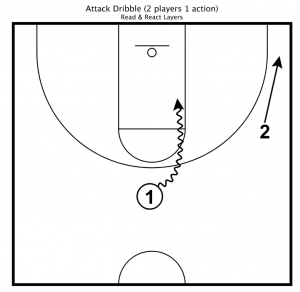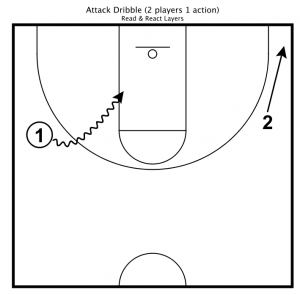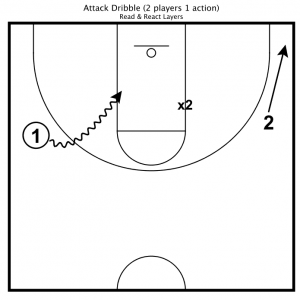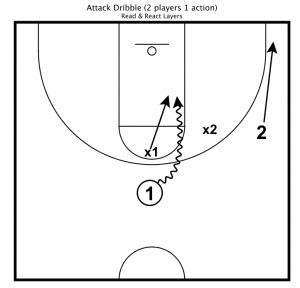The Breakdown for Attack Dribble
This will break down the Attack Dribble Layer starting with 2 player actions and including defense build up to 5 on 5. Individual skill development is critical but that’s another topic for another time.
One big question that some might ask: “What do I tell players when they pass?” For now, I’m not going to tell them anything, because we haven’t covered what to do when you pass. For some building blocks, you might tell them to step off the court. In others, you might tell them to rebound. In any case, they won’t have any decision to make I just don’t want them to worry about that right now. I want them to focus on the Attack Dribble Layer. This becomes important in being able to practice back to back actions. So for now, for any drill designed through any building block for this layer, the rule is if you make a pass, you (and your defender if one exists) step off the floor once you pass. When other layers are added, they will have “something to do.”
A. 2 offensive players 1 action
This building block is the most basic component for teaching this layer. Everything else will build off of this. Coaches will still want to conduct individual skill development drills first to teach the different fundamentals that make up the building block. However, this is the first time where players really learn how to play team offense. Players start at two designated spots. The player with the ball performs an attack dribble. The player without the ball rotates aggressively in the appropriate direction to the next spot. Is it really that simple? Sure it is; except it’s not. I’ll discuss the different things that can go wrong shortly. Let’s finish the building block first. The attacking player must make a decision on when the defense has committed to help with their attack. If they have their defender beaten and help doesn’t come, they should keep going. If the defense steps over to help, this means their teammate should be open and they should look to pass them the ball. In designing the drill from the building block, coaches should consider some of the following details:
Which spots are we using?
- There are plenty of combinations. Coaches should make sure players are comfortable attacking and rotating from all spots. Players should be adjacent to each other initially.
- As they become more comfortable, the two players can be located on any two spots. This will help teach the ball handler to read help defenders from different positions and to make passes to players all over the floor.
- Just remember, NO BASELINE DRIVES….yet.
What is the ball handler going to do?
- The ball handler can finish with a layup or a jump shot. The other player rotates. They must practice an aggressive rotation even if they aren’t going to get the ball.
- The ball handler takes 1 or 2 dribbles and kicks it out to the receiver who has rotated properly. The receiver shoots or attacks the basket. The initial ball handler is now out of the drill or maybe they are a rebounder.
- Initially predetermine the direction of the penetration. This is important for youth players who are new to the action. Eventually, all ball handlers must be given the freedom to choose the direction of the drive.
- Ball handlers attack off the dribble as opposed to off the catch. The question then becomes when do the receivers rotate. Once the ball handler enters a scoring area? After the ball handler crosses the 3-point line?
What can go wrong?
The ball handler…
-
- travels on the attack.
- gets his/her pocket picked
- dribbles with the wrong hand (e.g. going left with their right hand)
- dribbles too deep before they kick it out.
- stares down their receiver instead of selling the attack.
- doesn’t get downhill.
- passes with the wrong hand.
- makes a bad pass.
- pivots incorrectly.
Or the receiver…..
-
- rotates the wrong way or doesn’t rotate at all.
- reacts late
- isn’t aggressive in their rotation.
- isn’t ready to receive the pass.
- ruins spacing
- shoots a shot with a foot on the 3 point line.
- travels when they try to attack the basket.
There’s a lot that can go wrong in this simple 2 player building block. This also means that there is a lot you can teach out of this simple building block. Granted, a lot of these are basic fundamental skills but they will probably show up in other places as well. In any case, this is a great chance to teach, reinforce, and emphasize those skills in addition to learning the what happens when a player attacks the basket.
This is just the first block, but it’s such an important one. It is a great tool to drill all the offensive fundamentals associated with this layer as well as the team concept. The inability for players to execute the basic offensive fundamentals that make up this layer will lead to turnovers or bad shots. There are countless drills that can be created from this building block to teach any number of things. However, continuous repetition of this single building block for the purpose of improving offensive execution is ineffective since reactors are able to anticipate the initiator’s action. This is especially true at higher levels, but even youth teams will eventually need to be challenged more than basic 2 on 0 drills. So let’s add some defense.
B. 2 offensive players 1 defender on the ball 1 action
The only difference between this building block and the previous one is the addition of a defender. However, this one defender changes the dynamic of the drill. We will have the defender start guarding the attacker. This can be live or not, but the receiver must still react. If the defender is a dummy defender, it is up to the coach to specify what happens. If it is a live situation, the 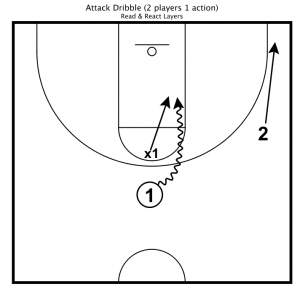
This is a good way to teach shot selection for the attacker. Is the attacked passing up opportunities to score? Can the attacker when the defender has played good defense? Do you have players that can score 1 on 1 even if the defense is good? The receiver must always rotate appropriately, even if they don’t receive a pass. The ball handler must be limited in the number of dribbles and/or space that they have to score. This might as well be called 1 on 1 with an outlet. However, there are a lot of offensive and defensive concepts that can be taught in this building block, not to mention the many different ways that the 1 on 1 situation can be created. Either way, why have players standing on the baseline watching two people play 1 on 1. Have them in spots on the court, practicing their reaction. Every repetition helps.
C. 2 offensive players 1 defender off the ball 1 action
Now we will start teaching the ball handler player to read the help-side defense. This drill will depend on your defensive philosophy. Place two offensive players in any two spots that you want. Then have a defender in help position. The ball handler must attack in a way that forces this defender to help. This building block can be used to teach 1 on 1 defense in a variety of ways as well as closeouts.
D. 2 offensive players 2 defenders 1 action
Next, for 2 player drills, we’ll add a second defender. What is your defensive philosophy for the second defender? Are they in the gap or up the line and on the line? Do they commit to helping on the drive? Do they take away the easy drive and kick? Is it based on the scouting report?
This building block may start as a way to teach offensive concepts but quickly turn into a way to teach closeouts or another defensive concept. When it comes to offense, only one action is allowed at this point. We haven’t taught what the ball handler is supposed to do after they pass. So for right now, they just step off the court along with the person defending them.
These building blocks show 2 offensive players with the ball handler attacking. Future posts will add offensive players to provide the ball handler with options on the attack. We have shown a maximum of 2 defensive players since there are only 2 offensive players. It may be useful to add defensive players to make the drill more challenging for the offense.

